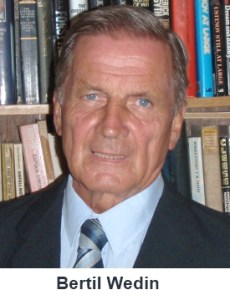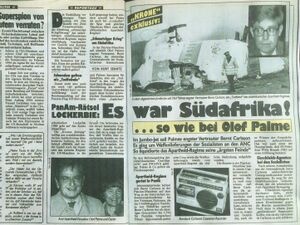Bertil Wedin
(spook) | |
|---|---|
 | |
| Born | 21 November 1940 |
| Died | 4 March 2022 (Age 81) |
Swedish spook named as a suspect in the Olof Palme assassination | |
Bertil Wedin was a Swedish secret service agent who was accused in an English court, but acquitted, of the 1982 burglary of the Pan Africanist Congress (PAC) office in London.
Bertil Wedin died in the Turkish Republic of Northern Cyprus on 4 March 2022.[1]
Contents
Background
Bertil Wedin's military experience includes service with the United Nations Forces in the Congo in 1963 and in Cyprus in 1964 and 1965, mainly as a Military Operations and Intelligence Officer. In 1967 he was appointed as the Director of the Swedish Industry Information Institute and as the Editor of its daily journal for industrialists and diplomats.
Having settled in England in 1976 he launched Industry International Research Institute and its weekly journal Industry International. He also worked with Brian Crozier, the strategist who had founded the London-based Institute for the Study of Conflict and later also started a private sector intelligence service.[2]
Olof Palme's assassin?
| Peter Caselton: accusing Bertil Wedin, excusing Anthony White |
In 1996, Bertil Wedin was named as a suspect in the assassination of Sweden's PM, Olof Palme, but denied any involvement.[3]
His accuser, Peter Caselton – who with eight others including Craig Williamson had applied for amnesty from South Africa's Truth and Reconciliation Commission for the March 1982 bombing of the ANC office in London – was allegedly a member of an apartheid South Africa assassination squad. He was also suspected of bombing the ANC Stockholm office in 1986. Wedin denied involvement in any crimes.
Bernt Carlsson knew too much
According to Ole Dammegård in his book “Coup d’Etat in Slow Motion” about the Assassination of Olof Palme:[4]
Swedish national, Bertil Wedin, who was recruited by South African superspy Craig Williamson, said:
- “I have the names of businessmen who know a lot about this – many things the investigators would need to know. A lot of information has been silenced.”
- “A diplomat (probably, Bernt Carlsson) knew about this, and told his friends in New York that he was afraid for his life. Some days later, he was one of the victims in the Lockerbie outrage of December 21, 1988, when Pan Am Flight 103 was blown to pieces over a small village in Scotland. In all, 270 people were killed. Bernt Carlsson was Palme’s closest co-worker in the mediating assignment between Iran and Iraq, and no doubt had insight into all aspects. At the time of his death, Bernt Carlsson – who was a sworn adversary of Apartheid – had just been appointed UN Commissioner for Namibia, and was seen as a serious threat by the white regime of South Africa.”
- According to Swedish newspaper Aftonbladet of 30 April 1991, Bernt Carlsson’s American girlfriend, Sanya Popovic, was told by Carlsson shortly before the Lockerbie catastrophe:
- “I am one of the four or five people who know what really happened to Olof Palme.”
- Because Bernt Carlsson knew too much, he had to be removed. Investigations by the Austrian newspaper Kronen Zeitung, proved that in fact South African agents had placed a specially-prepared bomb in Bernt Carlsson’s small tape recorder. By blowing up a whole passenger plane in the air, the motive was obscured, because the investigators had no possibility of knowing which one of the passengers was the target.[5]
TRC files
According to South African Truth and Reconciliation Commission files, Bertil Wedin (BW) also went by the code names "Morgan" and 'John Wilson':
- BW is a Swedish right-winger, who in the past had worked for Craig Williamson, acted as the initiator of the PKK-lead, which soon became the main lead in the search for Palme's killer. The Kurdish PKK is the Turkish government's main enemy, which has battled Ankara security forces in Turkey since 1984. BW seems to have faked this link with the PKK and passed it to a journalist on the Turkish daily Hurriyet. He located six or seven members of the PKK-group that killed Palme. This promotion of the PKK-lead was made more than three months before Hans Holmér, Stockholm chief of police and head of the Palme murder investigation, claimed for the first time that "PKK is behind the murder of Olof Palme." This became the investigation's main lead, with police chief Hans Holmér and Ebbe Carlsson as its promoter and lobbyist. A major police sweep of PKK sympathisers in Sweden followed but investigators later had to give up this lead.
- BW is a Swedish right wing extremist, and former informant for the Swedish security police. He always openly declared that he was working against the Swedish Social Democratic government and especially against Prime Minister Olof Palme.
- He is/was a friend of Göran Assar Oredsson, leader of the neo-nazi party Nordiska Rikspartiet. BW was an officer of the United Nations peace-keeping forces in the Congo (1961) and Cyprus (1963). In Cyprus he was a lieutenant, for several periods, on the staff intelligence unit in the UN forces.
- In 1966 (the year he resigned from the Swedish army) he went to the American embassy in Stockholm and demanded to be sent to Vietnam to fight. Nothing came of this plan. In 1967 BW was the driving force behind "The Committee for a Free Asia", a committee that was planning a counter-tribunal on Vietnam that would investigate "the murders and atrocities, committed by the communist side in the Vietnam War." At this time BW became a regular informant for the Swedish security police (Säpo). He supplied them with information on left-wing Swedes.
- At the same time as he was a security police informant, BW also worked for a Swedish bank (Stockholm Enskilda Bank). BW, who now calls himself a journalist, produces the newsletter Mediasammandrag (Media Summary) for the bank. Recently BW confirmed that he had been involved in military intelligence work.
- In 1976 a Swedish newspaper wrote that BW most probably was behind newspaper advertisements trying to recruit mercenaries for service in Southern Africa. The same year he moved with his family to England. On behalf of the Federation of Swedish Industries (Sweriges Industriforbund), the Swedish Employers' Federation (Svenska Arbetsgivarforeningen) and some 15 companies he arranged seminars and meetings in London, so that Swedish businessmen could met businessmen, politicians and thinkers from Britain.
- Craig Williamson (see below) recruited BW as a South African spy. BW said he had met Craig Williamson in SA in 1980. Williamson had introduced him to Peter Caselton, based in London, to whom BW had to report. Caselton was a British citizen, but a SA agent, who had given BW the codename 'John Wilson'.
- BW became involved in break-ins at various anti-apartheid organisation offices in London. A letter from Craig Williamson to BW resulted in a police search of the Swede's twelve-room house in Tonbridge, Kent. The police found stolen material, as well as notes from documents stolen from the office of the PAC. They also found a map over the area around the PAC office, showing the way to the underground station Dollis Hill, as well as sketches of the office itself.
- BW told the police that via a bank account in Switzerland, he was paid £1,000 pounds per month in salary by Williamson, plus costs. He also received camera equipment. After being interrogated at Rochester Row police station in London, the Swede was soon released on bail.
- As opposed to Caselton and Aspinall, BW declared himself not guilty at court proceedings in the Old Bailey on 17 December 1982. The judge agreed that he could remain free on bail. During the trial against him in April BW claimed never to have given the South Africans information. The judge noted that he then could not understand what BW had done to earn the money the SA had paid him. BW claimed that he had used the money to write a book on Soviet subversive activities, a work that to no one's knowledge was ever published. But BW admitted he had been at the PAC office on three occasions, but for the purpose of doing interviews. The map of the area around the PAC office and the underground, BW explained by saying he had "a bad memory" and needed it to find his way. He never had to account for the sketches of the inside of the office. The Swede was acquitted. However, after being acquitted BW admitted to the press that he had supplied information to the company Africa Aviation Consultants on the Isle of Man. But he claimed to have done it in "good faith", without knowing that Williamson's and Caselton's company was a front for the SA security service. In South Africa the Williamson-led London operation was regarded a greet success.
- in 1985 BW held a key position in an organisation called Victims Against Terrorism (VAT), a major SA propaganda operation in Europe. In May 1985 VAT staged a demonstration outside the ANC office in London, accusing the ANC of carrying out acts of terror. Later another South African agent (Arthur Kemp) became a leading figure in this organisation.
- In November 1985 BW and his family flew to Northern Cyprus. On their arrival cards they declared that they were going to settle there permanently. BW was issued with a Turk-Cypriot ID-card in March 1986. On at least one previous occasion the Swede had, for unknown reasons, gone to Cyprus (using the undercover name 'John Wilson') together with the SAn agent Peter Caselton. Right after his arrival in Northern Cyprus, BW was employed by the Ministry of Information there. Part of his job was to work for Radyo Bayrak, Turk-Cypriot radio. He used the radio to fire off vicious attacks against the Social Democrats and Olof Palme in particular. He was Middle East correspondent for the Swedish ultra-right journal Kontra (Counter-guerrilla).
- It is after the assassination of Palme that BW took on his new role as the initiator of the PKK lead. BW denied any involvement in the assassination of Olof Palme. (Based on an interview with and 5 articles written by Swedish journalist Anders Hasselbohm)[6]
Northern Cyprus
Three months before the assassination of Olof Palme, Bertil Wedin with his British wife Felicity moved to Kyrenia in Northern Cyprus, an infamous haven for anybody who wanted to avoid being extradited.[7]
Related Documents
| Title | Type | Publication date | Author(s) | Description |
|---|---|---|---|---|
| Document:Gordon Corera travels to Stockholm to investigate the assassination of a prime minister | Radio programme | 28 July 2014 | Gordon Corera | In BBC Radio 4's investigative history series - 'Document' - Gordon Corera investigates the assassination of the Swedish prime minister Olof Palme and explores what Britain knew, starting with boxes of documents including papers written by the late Stieg Larsson (deceased 9 November 2004) |
| Document:Olof Palme - The Man Who Played With Fire | book review | 2020 | Simon Matthews | Bernt Carlsson, a colleague of Olof Palme’s and UN Commissioner for Namibia 1987-1988, died in the Lockerbie bombing on 21 December 1988. Carlsson's presence on Pan Am Flight 103 has been cited as the reason it was bombed. |
References
- ↑ "Bertil Wedin – Rest in Peace"
- ↑ "Cyprusscene welcomes Bertil Wedin"
- ↑ "Bertil Wedin: 'I am not the murderer'"
- ↑ "Coup d'Etat in Slow Motion Vol I: The Murder of Olof Palme"
- ↑ Document:PanAm-Rätsel LOCKERBIE: Es war Südafrika!…so wie bei Olof Palme
- ↑ "The Truth Commission Files – The case of 'Olof Palme'"
- ↑ "Stieg Larsson and the unsolved murder case of Olof Palme"
Wikipedia is not affiliated with Wikispooks. Original page source here
